Dr. Lalitha Subramanian
About the Author

Aksharam
An exponential function in $x$ is a function of the form $f(x) = a \ast b^x$, where $a$ and $b$ are real numbers, $a \neq 0$, and $b \neq 1$.
The constant $a$ is called the
Evaluate $f(x) = 3^x$ for $(a)$ $x = 2$; $(b)$ $x = -1$; $(c)$ $x = 0$; and $(d)$ $x = \frac{3}{2}$; $(e)$ $x = \sqrt{2}$.
Solution: $(a)$ $f(2) = 3^2 = 9$ $(b)$ $f(-1) = 3^{-1} = \frac{1}{3}$ $(c)$ $f(0) = 3^0 = 1$ $(d)$ $f(\frac{3}{2}) = 3^{\frac{3}{2}} = \sqrt{27} = 3\sqrt{3}$ $(e)$ $f(\sqrt{2}) = 3^{\sqrt{2}} \approx 4.7288$
Graph of any exponential function can be sketched by constructing a table of values.
Sketch the graph of $(a)$ $f(x) = 2^x$; $(b)$ $g(x) = 2^{-x}$; $(c)$ $h(x) = \left(\frac{1}{3}\right)^x$
Solution:
$(a)$ Construct table of values: \begin{array}{ccc} \hline x & y & (x,y) \\ \hline -2 & 2^{-2} = \frac{1}{2^2} = \frac{1}{4} & (-2, \frac{1}{4})\\
-1 & 2^{-1} = \frac{1}{2} & (-1, \frac{1}{2})\\ 0 & 2^0 = 1 & (0, 1)\\ 1 & 2^1 = 2 & (1, 2)\\ 2 & 2^2 = 4 & (2, 4)\\ \hline \end{array}
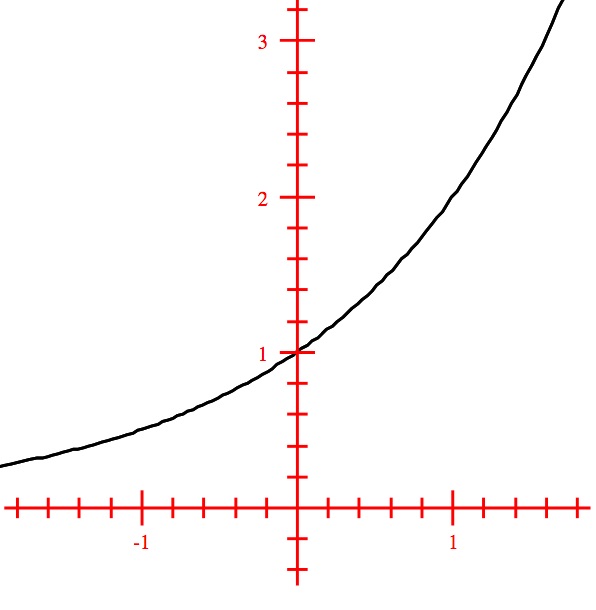
$(b)$ Table of values: \begin{array}{ccc} \hline x & y & (x,y)\\ \hline -2 & 2^2 = 4 & (-2,4)\\ -1 & 2^1 = 2 & (-1, 2)\\ 0 & 2^0 = 1 & (0,1)\\
1 & 2^{-1} = \frac{1}{2} & (1, \frac{1}{2})\\ 2 & 2^{-2} = \frac{1}{4} & (2, \frac{1}{4})\\ \hline \end{array}
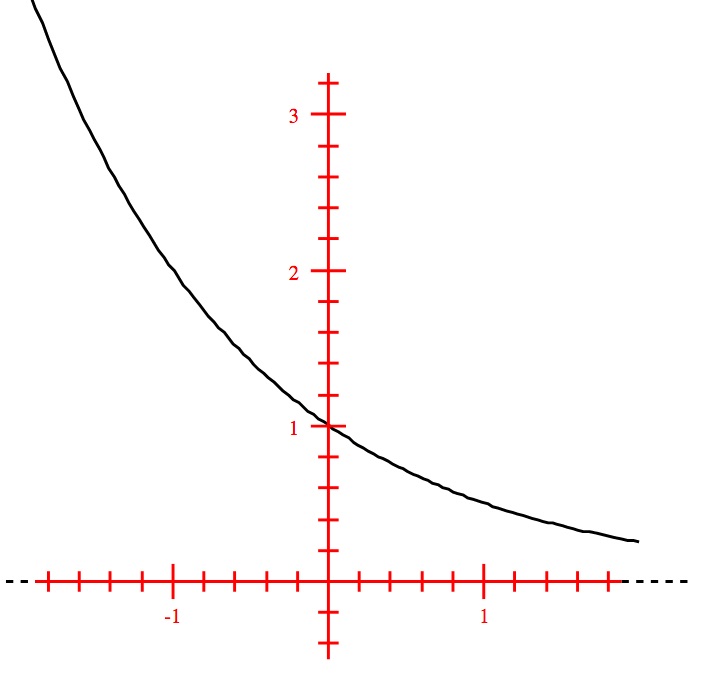
$(c)$ Table of values: \begin{array}{ccc} \hline x & y & (x,y)\\ \hline -2 & \frac{1}{3^{-2}} = 3^2 = 9 & (-2, 9)\\ -1 & \frac{1}{3^{-1}} = 3 & (-1, 3)\\
0 & \frac{1}{3^0} = 1 & (0, 1)\\ 1 & \frac{1}{3^1} = \frac{1}{3} & (1, \frac{1}{3})\\ 2 & \frac{1}{3^2} = \frac{1}{9} & (2, \frac{1}{9})\\ \hline \end{array}
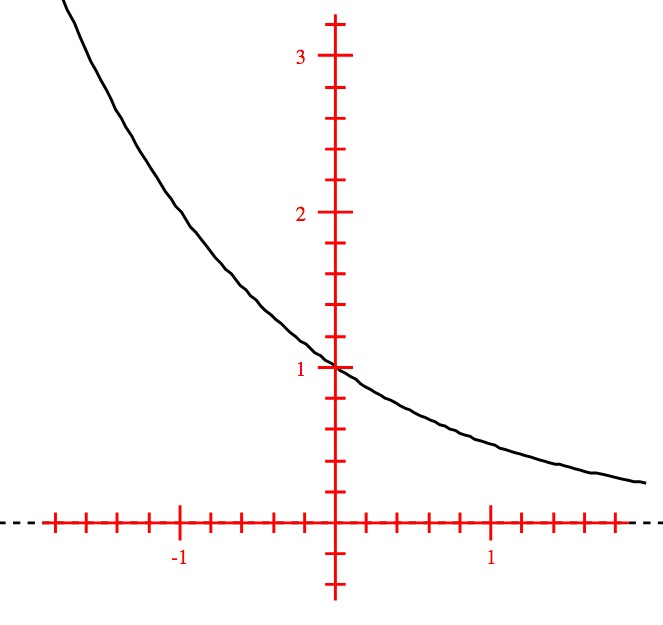
Observing the above examples and similar ones, we conclude the following properties of the graph of an exponential function:
Based on the above examples, we can sketch the graphs of any exponential function using transformations. Some examples are shown below:
Sketch the graphs of the following functions. Describe the steps of transformations and show each step in your sketch:
$(a)$ $f(x)=2^x-3$
$(b)$ $g(x)= 3^{(x+1)}$
$(c)$ $h(x)= 3 \ast 2^x$
Solution:
$(a)$ The graph of $f(x)=2^x-3$ is obtained by translating the graph of $y=2^x$ down by $3$ units.
$(b)$ The graph of $g(x)=3^{(x+1)}$ is obtained by translating the graph of $y=3^x$ towards left by $1$ unit.
$(c)$ The graph of $h(x)=3 \ast 2^x$ is obtained by vertically stretching the graph of $y=2^x$ by a scale factor of 3 units.
One special function of all exponential functions is $f(x)=e^x$. The special real number $e$ is irrational, and is the limiting number of the expression $\left(1+\frac{1}{n}\right)^{n}$ for any natural number $n$, as $n$ increases and tends to $\infty$. This means that, as $n$ increases, the expression $\left(1+\frac{1}{n}\right)^{n}$ approaches $e$, which is approximately $2.71826.....$. Due to its wide applications in solving real world problems using calculus, algebra, etc., $e$ is given the special status of natural base and the function $f(x) = e^x$ is considered as the natural exponential function. Another special base is the number $10$, as this is the base of our number system. Hence, the exponential function $f(x)=10^x$ is considered as the common exponential function.
A logistic growth function is of the form $f(x)=\frac{c}{1+a \ast b^x}$, where $a, b, c,$ and $k$ are positive constants with $b\lt 1$. The constant $c$ is referred to as the limit to growth. For $b \gt 1$, this is called logistic decay function.
For any positive number $b \neq 1$, the expression $b^x$ can be written as $e^{-kx}$ by determining a suitable value for $k$. In particular, the logistic growth function can be written as $f(x)=\frac{c}{1+a \ast e^{-kx}}$ for some value of $k$. By setting $a = c = k = 1$, we obtain a special function $f(x) = \frac{1}{1+e^{-x}}$. This is called the logistic function. . Graph of a logistic function CANNOT be obtained by any transformation of the basic function $y=e^x$. The graph of this function is shown below:
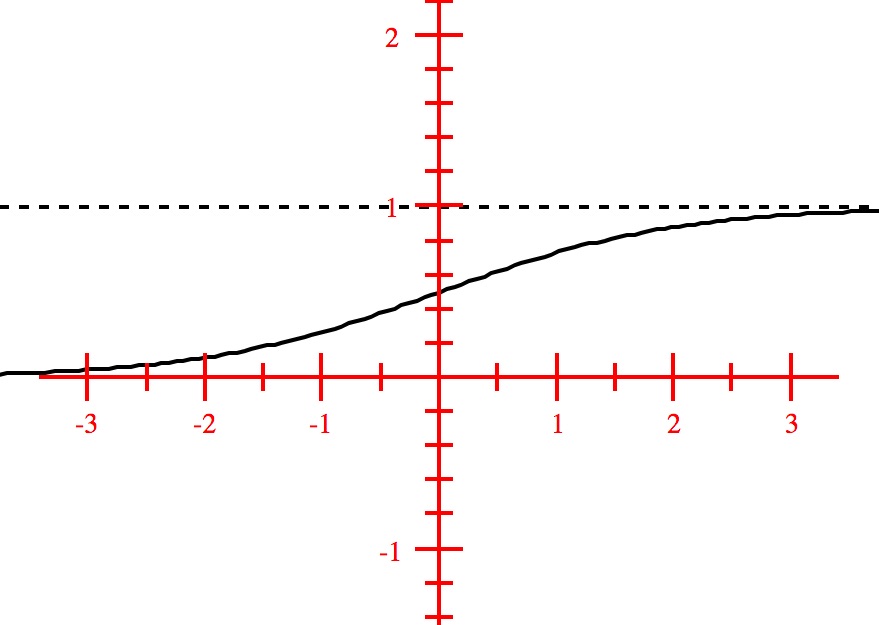
Propertries of the graph of the logistic function:
Both exponential and logistic functions are widely useful in modeling real life situations wherever growh and decay are experienced. Application problems are discussed in detail in the last module of this section.
Solving equations of exponential expressions involves the following property in addition to the fundamental properties of exponents:
Solve the equations:
$(a)$ $3^{2x+5} = 9^{3x+1}$;
$(b)$ $4\left(\frac{1}{4}\right)^{2x-1} = 2\left(\frac{1}{32}\right)^{x-2}$
Solution:
$(a)$ Note that the bases are not same. But, we can make them same by setting $9=3^2$. Rewriting the equation with equal bases and solving: \begin{eqnarray} 3^{2x+5} &=& 9^{3x+1}\\ 3^{2x+5} &=& 3^{2(3x+1)}\\ 3^{2x+5} &=& 3^{6x+2}\\ 2x+5 &=& 6x+2\\ -4x &=& -3\\ x &=& \frac{3}{4}\\ \end{eqnarray}
$(b)$ Here, we can rewrite the equation such that both sides have the base $2$ as $4 = 2^2$ and $32 = 2^5$, and then solve the equation: \begin{eqnarray} 4\left(\frac{1}{4}\right)^{2x-1} &=& 2\left(\frac{1}{32}\right)^{x-2}\\ (2^2)(2^{-2(2x-1)}) &=& (2)(2^{-5(x-2)})\\ 2^{2-2(2x-1)} &=& 2^{1-5(x-2)}\\ 2^{2-4x+2} &=& 2^{1-5x+10}\\ 2^{4-4x} &=& 2^{-5x+9}\\ 4-4x &=& -5x+9\\ x &=& 5\\ \end{eqnarray}
No.
Yes. Base of the function is $0.8$ and its initial value is $1$.
No.
No.
Yes. Base of this function is $0.45$ and the initial value is $35$.
$f(2)=45$
$f(-1)=-\frac{1}{2}$
First sketch the graph of the basic function $g(x)=3^x.$ Secondly, translate this to the left by $4$ units. After that, use vertical stretch by a scale factor of $2$ units to get the graph of $f(x)$.
Horizontal shrink by a scale factor of $\frac{1}{2}$ gives the graph of $y=e^{2x}$. Vertical stretch of this by a scale factor of $3$ would result in the graph of $y=3e^{2x}$. Lastly, vertical translation of this graph up by $1$ unit would give the required graph of $f(x)=3e^{2x}+1$.
$x=3$
$x=\frac{1}{6}$
$y$- intercept is $y = f(0) = \frac{9}{1+2} = 3$; the constant $9$ is the limit to growth; The horizontal asymptotes are $y = 0$ and $y=9$.
$y$-intercept is $f(0) = \frac{5}{1+1} \ \frac{5}{2}$; Limit to growth is $5$; Horizontal asymptotes are $y=0$ and $y=5$.
Graph is shown below. The basic graph $y=2^x$ is shown as purple curve. The graph os $y=2^{x-1}$ is got by translating the basic graph $1$ unit to the right. This graph is shown as blue curve. The graph os $y=2^{x-1}+3$ is obtained by translating the previous curve up by $3$ units. This final graph is shown as black curve.
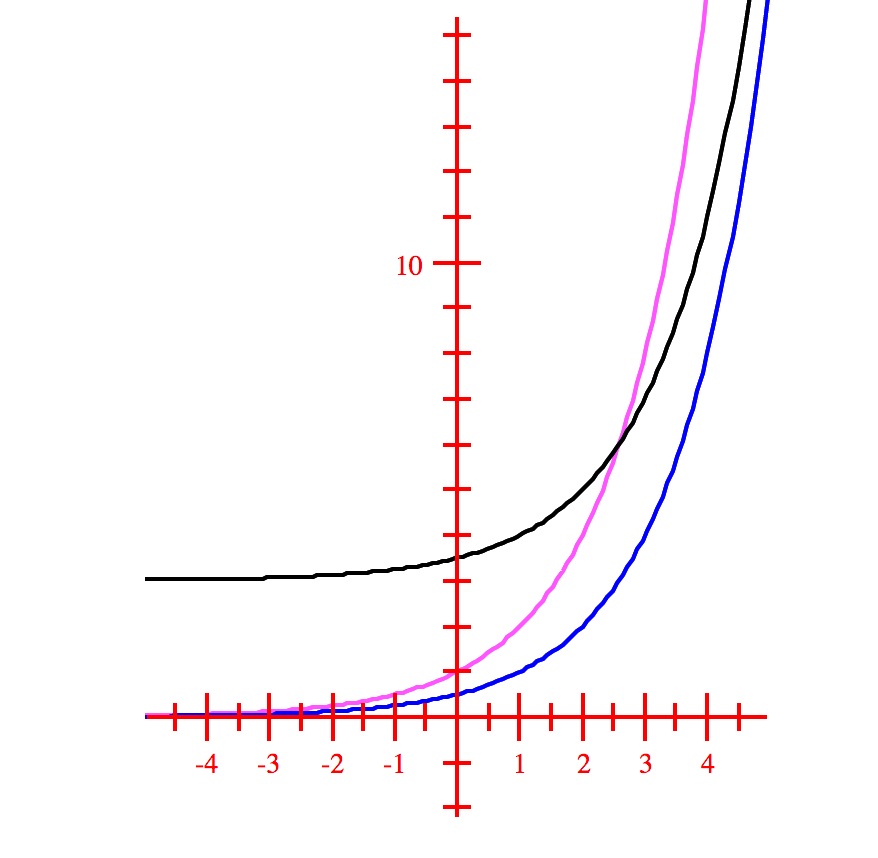
The graph of the basic function $y=3^x$ is shown in purple color. Graph of $y=3^{x=1}$ is got by horizontal shift of $1$ unit to the left. this graph is shown in blue color. The final graph os $y=2(3)^{x+1}$ is got be vertical stretch of the previous graph by a scale factor of $2$ units. This graph is shown in black color.
